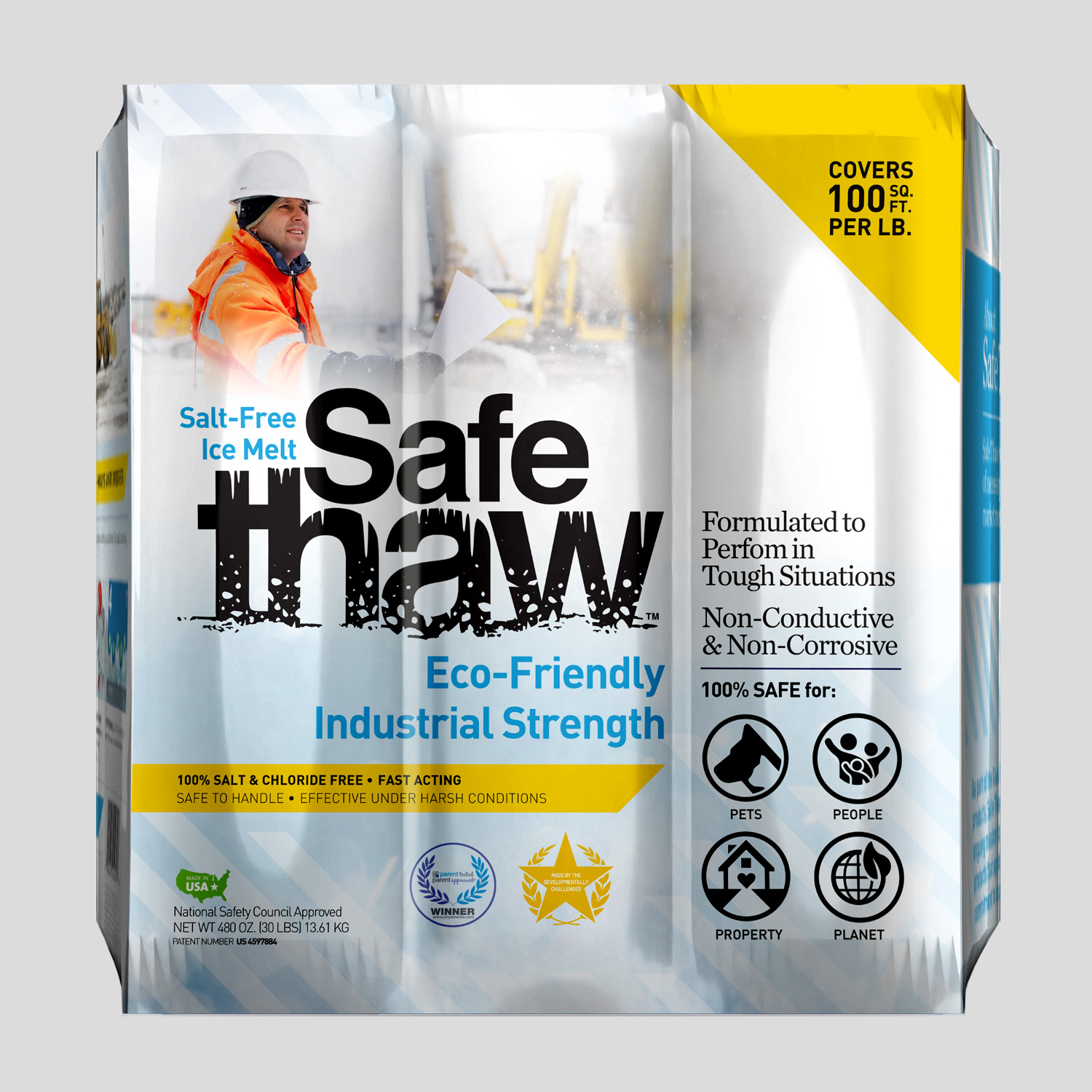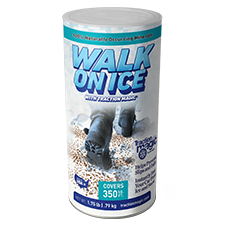Choosing Salts That Won’t Harm Concrete Surfaces

Winter presents an array of challenges, with icy pathways being one of the most treacherous. Many homeowners reach for salt as their first line of defense against the icy menace. However, not all salts are created equal when it comes to their effects on concrete. How does one navigate the vast array of products available and pick a concrete safe salt? Let’s delve into the subject and arm you with the knowledge to make an informed decision.

Safe Thaw
Safe Thaw was created as the ice management solution for tough winter environments. Ideal in commercial and industrial properties, shops, government agencies, bridges, and construction.
Why Traditional Salt Can Be A Concrete Nightmare
Using regular rock salt or sodium chloride on your driveway and walkways may seem like a convenient and immediate solution. Still, it comes with a price that your concrete surfaces might pay over time:
- Accelerated Deterioration: Salts can expedite the freeze-thaw process in concrete. This continuous cycle can cause scaling, which manifests as the flaking or peeling of the concrete’s surface.
- Corrosive Impact: Beyond the superficial damage, salts can also corrode the metal reinforcements inside the concrete, compromising the structural integrity of the surface.
- Increased Porosity: Salt can increase the concrete’s porosity, making it more susceptible to staining, moisture damage, and further salt penetration.
Seeking Alternatives: What To Use Instead Of Salt On Concrete
Given the drawbacks of using traditional salts on concrete, it’s paramount to consider alternatives that are both effective and gentler on the concrete.
- Potassium Chloride: Unlike its sodium counterpart, potassium chloride is less aggressive on concrete. However, it’s worth noting that it’s not as effective at lower temperatures.
- Calcium Chloride: Often available in a pellet form, calcium chloride melts ice faster than many other agents. It’s more effective in extremely cold conditions but can leave a slippery residue, so use with caution.
- Sand or Kitty Litter: While these don’t melt ice, they can provide traction on slippery surfaces. They’re non-corrosive and won’t harm the concrete but will need a thorough cleanup once the ice has melted.
The Gold Standard: Safe Thaw
While the aforementioned alternatives offer a degree of safety for your concrete surfaces, the ultimate solution lies in products specifically designed for this purpose. Safe Thaw stands out in this category. This granular ice melt is chemical and toxin-free, ensuring rapid ice melting without the harmful side effects typically associated with salts. Here’s why Safe Thaw is a game-changer:
- Eco-Friendly: No chemicals mean it’s safe not just for your concrete, but also for the environment, pets, and plants.
- Effective Melting: Despite its gentle composition, Safe Thaw doesn’t compromise on effectiveness. It combats ice rapidly, ensuring that your pathways are safe and walkable.
- No Residue: Say goodbye to the slippery, slushy mess that some ice melters leave behind. Safe Thaw offers a clean melt, so there’s no post-melt cleanup required.
Concrete Scaling: Why It Happens And How To Prevent It
But even after choosing smarter alternatives, there’s still one problem people notice after a few winters—concrete scaling. You’ve probably seen it before: that flaky, peeling surface that shows up when ice and moisture keep stressing the slab. The truth is, scaling isn’t just about one bad product—it’s the long-term effect of freeze-thaw cycles made worse by the wrong deicers.
So, how do you prevent it? The answer lies in using a chloride-free formula that doesn’t invite water deeper into the pores of the concrete. Traditional salts set the stage for scaling because they encourage moisture to sit where it shouldn’t. A product like Safe Thaw, on the other hand, breaks the surface bond, melts the ice, and leaves a protective barrier that slows water absorption. In practice, that means fewer chances for peeling and flaking when the temperatures keep rising and falling.
Is Asphalt Or Concrete Cheaper In The Long Run?
Another thing people often ask while weighing their options is this: is asphalt or concrete cheaper when it comes to driveways? At first glance, asphalt usually wins the budget race. It’s quicker to install, the upfront cost is lower, and repairs can seem more manageable in the short term. But when you take the long view, the story changes.
That’s where the best ice melt for concrete levels the playing field. When Safe Thaw is used consistently, concrete retains its strength and appearance far longer, which makes the “cheaper” asphalt option look less appealing in the long term. So, while asphalt might save you a few dollars up front, concrete paired with the right ice melt solution usually proves to be the more cost-effective investment over the years.
How Long Does It Take For Salt To Damage Concrete?
Here’s a question that doesn’t get asked enough: how long does it take for salt to damage concrete? Most people assume it takes years of exposure, but in reality, the damage can start showing after just one or two tough winters. At first, it might be tiny hairline cracks or small discolored patches. But once salt has made its way into the pores, every freeze-thaw cycle acts like a wedge, prying the slab apart bit by bit.
By the third or fourth winter, those subtle changes often turn into scaling, pits, or even spalling chunks. And once concrete reaches that stage, repairs become both expensive and time-consuming. The frustrating part is that the process is silent—you don’t notice the damage until it’s already well underway.
Using a concrete safe ice melt changes that outcome. Instead of feeding the cycle, it works with your surface by keeping ice from bonding tightly in the first place. It means less stress on the material, fewer hidden cracks forming, and a driveway that still looks good when spring finally rolls around. So, while salt damage feels inevitable, it doesn’t have to be if you make the switch early.
Best Ice Melt For Concrete: What Sets Safe Thaw Apart
So, what exactly makes something the best ice melt for concrete and not just “less damaging”? It comes down to three things: effectiveness, safety, and prevention. Plenty of products melt ice quickly, but they compromise safety in one way or another—whether that’s corroding surfaces, burning vegetation, or leaving behind a slick residue that creates new slip hazards.
Safe Thaw stands apart because it balances all three. It melts ice rapidly thanks to its modified crystalline amide core and special glycols, but it also prevents refreezing for up to 72 hours. That means you don’t have to keep reapplying after every freeze. On top of that, it’s non-toxic, chloride-free, and eco-friendly, so you’re not trading your driveway’s health for short-term results.
Another detail worth mentioning is cleanup—or rather, the lack of it. While calcium chloride and acetates can leave behind a greasy or powdery mess, Safe Thaw melts clean. There’s no slush line, no residue, and no extra work once the storm has passed. In other words, it checks the boxes for both convenience and long-term concrete care.
Thinking Beyond Winter— Protecting Value And Safety of Your Property
At the end of the day, this isn’t just about surviving one storm. It’s about what your property looks like season after season. If you’re asking yourself whether asphalt or concrete is cheaper, or how long salt takes to damage a surface, you’re already thinking about the bigger picture—and that’s a good thing.
The truth is, every choice you make in winter affects your property’s value in spring. Concrete scaling, cracking, and porosity don’t just appear overnight; they’re the result of repeated decisions to use products that chip away at the surface. Once you shift to a concrete safe ice melt, you stop feeding that cycle.
So, when you’re weighing your options, remember: it’s not just about melting ice—it’s about protecting your investment.
100% salt & chloride-free, fast acting Ice Management Solution
Conclusion
Winter ice control doesn’t have to mean trading safety for damage. Traditional salts may seem like quick fixes, but they bring hidden costs—concrete scaling, shortened surface life, and expensive spring repairs. Asking the right questions—is asphalt or concrete cheaper, how long does it take for salt to damage concrete, and what really is the best ice melt for concrete—helps uncover the truth.
Safe Thaw answers those questions with a formula that does more than just clear pathways. It protects surfaces, preserves curb appeal, and gives you long-term value without the headaches. This winter, don’t settle for the cycle of patching and replacing. Choose the product that keeps your concrete strong, safe, and ready for many winters to come. Choose Safe Thaw.
Try Also Our Other Winter Safety Products:
Safe Paw
The Original and #1 Selling Pet and Child Safe Ice Melt for over 20 years. Guaranteed environmentally safe –It won’t harm animals or children, and it won’t damage your property. That’s Safe Paw. Safe Paw can change how winter affects our planet.

Walk On Ice
The handy disposable canister can be taken everywhere, with the same 100% naturally occurring minerals that provide instant traction on ice or snow. Use it on sidewalks, steps, or as an instant traction agent for your car.



